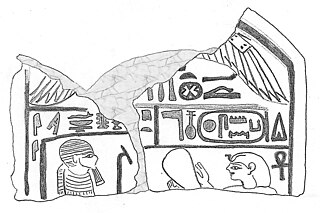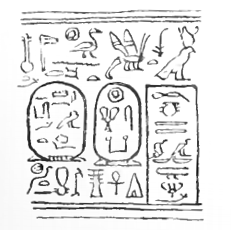
Hor Awibre was an Egyptian pharaoh of the early 13th Dynasty in the late Middle Kingdom.

Merhotepre Sobekhotep was an Egyptian king of the late 13th Dynasty during the Second Intermediate Period.

Sekhemkare Amenemhat V was an Egyptian pharaoh of the early 13th Dynasty during the Second Intermediate Period.
Renseneb Amenemhat was an Egyptian pharaoh of the 13th Dynasty during the Second Intermediate Period. According to egyptologist Kim Ryholt, Renseneb was the 14th king of the dynasty, while Detlef Franke sees him as the 13th ruler and Jürgen von Beckerath as the 16th. Renseneb is poorly attested and his throne name remains unknown.

Semenkare Nebnuni is a poorly attested pharaoh of the early 13th Dynasty during the Second Intermediate Period. He is mainly known for his position in the Turin King List.

Ameny Qemau was an Egyptian pharaoh of the early 13th Dynasty in the late Middle Kingdom.

Sehetepibre Sewesekhtawy was an Egyptian pharaoh of the 13th Dynasty during the early Second Intermediate Period, possibly the fifth or tenth king of the Dynasty.

Seankhibre Ameny Antef Amenemhat VI was an Egyptian pharaoh of the early Thirteenth Dynasty.
Iufni was an ancient Egyptian pharaoh of the 13th Dynasty during the Second Intermediate Period.
Sewadjkare was an Egyptian pharaoh of the 13th Dynasty during the early Second Intermediate Period.

Khahotepre Sobekhotep VI was an Egyptian king of the late 13th Dynasty during the Second Intermediate Period.
Nedjemibre was an ephemeral Egyptian pharaoh of the 13th Dynasty of Egypt during the Second Intermediate Period reigning c. 1780 BC or 1736 BC.

Mershepsesre Ini was a pharaoh of the late 13th Dynasty, possibly the forty-sixth king of this dynasty. He reigned over Upper Egypt during the mid-17th century BC.

Sekhemkare Amenemhat Senebef was an Egyptian pharaoh of the early 13th Dynasty, often considered as the final part of the late Middle Kingdom or early Second Intermediate Period.

The Abydos Dynasty is hypothesized to have been a short-lived local dynasty ruling over parts of Middle and Upper Egypt during the Second Intermediate Period in Ancient Egypt. The Abydos Dynasty would have been contemporaneous with the Fifteenth and Sixteenth Dynasties, from approximately 1650 to 1600 BC. It would have been based in or around Abydos and its royal necropolis might have been located at the foot of the Mountain of Anubis, a hill resembling a pyramid in the Abydene desert, close to a rock-cut tomb built for pharaoh Senusret III.

Sekhemraneferkhau Wepwawetemsaf was an Egyptian pharaoh during the Second Intermediate Period.

Menkhaure Snaaib was an Egyptian pharaoh during the Second Intermediate Period between the Middle Kingdom and New Kingdom at the end of the Middle Bronze Age.

Sekhemrekhutawy Pantjeny was an Egyptian pharaoh during the Second Intermediate Period. According to the Egyptologists Kim Ryholt and Darrell Baker, he was a king of the Abydos Dynasty, although they leave his position within this dynasty undetermined. Alternatively, Pantjeny could be a king of the late 16th Dynasty. According to Jürgen von Beckerath, Pantjeny is to be identified with Sekhemrekhutawy Khabaw, whom he sees as the third king of the 13th Dynasty.

Sekhemrekhutawy Khabaw was an Egyptian pharaoh of the early 13th Dynasty during the Second Intermediate Period.
Sewadjkare III was an Egyptian pharaoh of the Fourteenth Dynasty of Egypt during the Second Intermediate Period c. 1700 BC. As a king of the 14th Dynasty, Sewadjkare III would have reigned from Avaris over the eastern Nile Delta and possibly over the western Delta as well.















